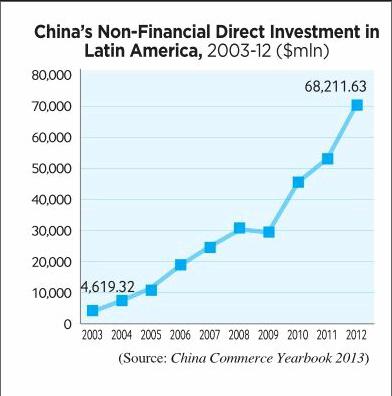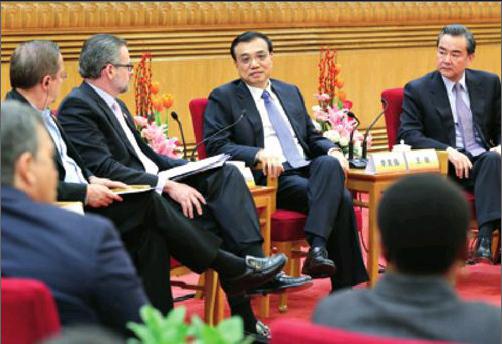Vibrant Integration
2015-02-05ByYuLintao
By+Yu+Lintao



The two-day First Ministerial Meeting of the Forum of China and the Community of Latin American and Caribbean States(CELAC) concluded in Beijing on January 9, with both sides vowing to deepen political mutual trust, expand cooperation and pro- mote the forums development. The platform is thus becoming a new part of Chinas “1+N”multilateral diplomatic network, which also includes China-Southeast Asia, China-Africa and China-Arab cooperation mechanisms as well as the Shanghai Cooperation Organization consisting of China, its Central Asian neighbors and Russia.
Established in December 2011 in Caracas, Venezuela, CELAC is a bloc of 33 members, including all South American countries, some Caribbean states and Mexico. The ministerial meeting in Beijing welcomed representatives of 30 CELAC countries. Chinese President Xi Jinping, Costa Rican President Luis Guillermo Solis, Ecuadoran President Rafael Correa Delgado, Venezuelan President Nicolas Maduro Moros as well as Bahamas Prime Minister Perry Christie attended the opening ceremony of the meeting.
Observers said that the Beijing meeting marked a significant step forward for overall relations between China and CELAC.
Benefits for all
Compared with Chinas cooperation platforms with other regions, the year-old China-CELAC Forum is a late arrival. In July 2014, Chinese President Xi and CELAC leaders announced the establishment of the China-CELAC Forum at the First ChinaLatin America and the Caribbean Summit in Brasilia, Brazil. They also agreed to hold the forums first ministerial meeting as soon as it could be arranged.
Latin America is now one of the worlds most vibrant regions in terms of economic development, and its role on the world political stage has also become much more prominent. China and countries in the region share similar aspirations to raise the global profile of emerging economies and that of developing countries, laying the foundations for their dynamic partnership.
Over the past decade, trade between China and Latin America has maintained a formidable annual growth rate of 30 percent and trade volume between the two sides increased 20-fold to $261.6 billion from 2002 to 2013, making China the second largest trading partner of the region as a whole. Meanwhile, Latin America has already become Chinas second largest investment destination after Asia with Chinas direct investment to the region totaling $861 billion in 2013. Additionally, Latin America is the third largest source of foreign investment for China. Since Xi took office as Chinese president in March 2013, he has visited Latin America twice, showing the importance China attaches to the region.
However, dialogues and cooperation between the two sides have been mostly conducted via bilateral channels. This method of interaction could prove less efficient at a time when cross-region cooperation calls for a more comprehensive mechanism.
Cui Shoujun, an associate professor on Latin American studies at the Beijing-based Renmin University of China, noted that besides the remote geographical distance, the lack of an integrated regional platform in the past was to blame for the lagging behind of overall China-Latin America relations. In addition, Cui said there are still 12 countries in the region that have not established official relations with China.
Nevertheless, the rapid development of globalization and regional integration has gradually overcome the hurdles between the two. The establishment of CELAC, in particular, has created an opportunity for the overall cooperation between China and Latin America as a whole.
Currently, most Latin American countries are urgently pursuing development. Wu Hongying, Director of the Latin American Institute under the China Institutes of Contemporary International Relations(CICIR), said that Chinas rich experience in such development has helped pave the way for cooperation between China and Latin American nations.
Wu added that the cooperation between the two sides is an important supplement to the bilateral collaboration between China and regional countries, for which the Beijing ministerial meeting has mapped out the approaches and directions.
In a recent article published in Chinas leading newspaper Peoples Daily, JoséMaría Guijarro García, Undersecretary of Africa, Asia and Oceania of the Ecuadorian Ministry of Foreign Affairs, wrote that the First Ministerial Meeting of the ChinaCELAC Forum was a feast of deepening mutually beneficial cooperation between Latin America and China. As China is a major engine of the world economy, the stable development of the Latin American economy cannot be separated from close cooperation with China, he said.
Professor Cui believes that via the new cooperation platform, China and Latin American countries could better explore the potential for cooperating with one another so as to achieve common development, thereby following the general trend of the times that features cross-regional cooperation in a multi-polar world.
Tangible cooperation
Before the Beijing meeting, a report published by the UN Economic Commission for Latin America and the Caribbean said that economic reforms underway in China of-fer Latin America “a historic opportunity to make a qualitative and quantitative leap forward in its economic and trade relations with the Asian power.”
Traditionally, Latin America has provided a vast market for Chinese products and is also a big supplier of raw materials for Chinas manufacturing sector. At the same time, the high-speed economic growth of China has also pushed up the bulk commodity export of the region, bringing concrete benefits for regional countries. The First Ministerial Meeting of the China-CELAC Forum was held under the theme New Platform, New Starting Point, New Opportunity—Joint Efforts to Promote China-Latin America and the Caribbean Partnership of Comprehensive Cooperation.
This new tendency had first emerged as early as half a year ago. During Xis last visit to Latin America in July 2014, he proposed building a “1+3+6” cooperation framework between both sides.
Within the framework, bilateral cooperation will be based on the Chinese- Latin American and Caribbean Countries Cooperation Plan (2015-19) and be advanced through three major approaches—trade, investment and financial cooperation. Their priorities focus on six fields including energy and resources, infrastructure construction, agriculture, manufacturing, scientific and technological innovation, and information technology.
The Beijing ministerial meeting has enriched the specific measures of the 2015-19 cooperation plan. The two sides will strive to achieve a trade volume of $500 billion and investment of at least $250 billion within a decade. Cooperation on services, infrastructure, finance, high technology and e-commerce are further emphasized in the plan. Civil aviation authorities and enterprises are encouraged to cooperate more and explore the possibility of increasing flights between China and Latin American countries to expand bilateral exchanges.
Observers noted that besides the traditional cooperation in resources and energy, the other five fields under the “1+3+6” coop- eration framework will certainly become new stimuli for future cooperation between the two sides.
Wu with the CICIR predicted that the hitech cooperation between China and Latin American countries, which is mainly limited to satellite development and launches at present, will expand. China is reportedly planning to enhance collaboration with Chile on astronomical research and with Argentina on nuclear power development.
Besides the cooperation plan, other cooperation initiatives have also been put forward. The $20-billion special loans for China-Latin America infrastructure cooperation, the $10-billion preferential loans for Latin American countries as well as the$5-billion China-CELAC Cooperation Fund that China promised previously have been in operation or are soon to be launched. The $50-million China-Latin America Infrastructure Cooperation Special Fund has also started to invest in specific projects.

In addition, China has promised 6,000 government scholarships for CELAC mem-bers from 2015 to 2019 and will set up Chinese language courses in primary and middle schools in those countries.
According to a declaration adopted at the Beijing meeting, China and CELAC will coordinate on major global issues, and work together on multilateral policy-making with more exchanges between legislatures, governments and youth.
Latin American media and academic circles have shown great interest in the cooperation between the two sides. A recent report by the Venezuela News Agency said that the “1+3+6” cooperation framework has heralded a new chapter in China-CELAC cooperation. It added that the six fields of cooperation and close people-to-people cooperation proposed by China are “specific”and “pragmatic.”
In his Peoples Daily article, García wrote that China and Latin American countries have made remarkable breakthroughs in cooperation on technology transfer and finance.
In an interview with Chinas Xinhua News Agency, Severino Cabral, Director of Brazils Institute of China and Asia-Pacific Studies, said that Chinas proposals for building a broader and more flexible cooperation platform would mobilize all Latin American and Caribbean countries to integrate themselves into global common development via their cooperation with China, and would mark a new epoch for the development of China-CELAC relations as well as the world economy.
Marco Navas, an Ecuadoran expert on international issues, said that the Chinese proposal is “exciting” and sends a positive signal for advancing the China-CELAC comprehensive cooperative partnership, noting that the door to “China opportunities” is being opened to the Latin American and Caribbean region.
Outside reactions
Most Western media outlets interpreted the First Ministerial Meeting of the China-CELAC Forum as a sign of growing Chinese influence in Latin America, while some read too deeply into Chinas move as a way to wean off the United States. However, officials and observers from China and Latin American countries do not see it that way.
Wu with the CICIR claimed that with its geographical vicinity and traditional links, the United States enjoys a much larger influence on Latin American countries in terms of both economy and security.
Wu Baiyi, Director of the Institute of Latin American Studies under the Chinese Academy of Social Sciences, said that Chinas cooperation with CELAC does not necessarily constitute competition with the United States as the two are at different development stages. Chinas cooperation with Latin America can be seen as a kind of complement to that of the United States, according to Wu Baiyi.
García also emphasized in his article that the China-CELAC cooperation does not hurt any third party. Latin America is not merely the “backyard” of any country—rather, it seeks international cooperation based on its own needs for development and the balance of international relations.
When addressing the closing ceremony of the Beijing ministerial meeting, Chinese Foreign Minister Wang Yi said that the ChinaCELAC cooperation is “open, inclusive and balanced” and excludes no third party.
“In cooperation with developing countries, China will consider their need for selfdevelopment instead of simply trade and investment or mere one-off sales of resources and energy,” Wang said.
